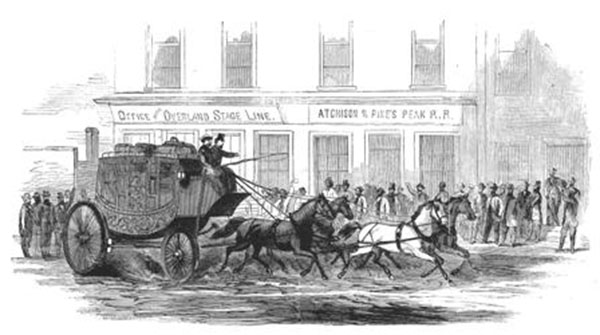John Butterfield’s Overland Mail Company made history by carrying mail and passengers cross-country beginning in 1858 – but the enterprise was short-lived.
Mail service in America has been evolving since colonial times: post rider, postal coach, sailboat and steamboat, train, automobile and truck, airplane. For a brief period just before the Civil War, an enterprising ex-stagecoach driver was the nation’s postman of the hour.
Westward Expansion & the Demand for Mail
California was admitted to the Union in 1850. By then, frontier settlements up and down the West Coast had blossomed into thriving towns and cities.
Westerners longed for regular contact with their eastern relations, and vice versa. At the time, the fastest way to transport mail from coast to coast was by sea. Mail ships would sail from New York and Charleston, South Carolina, to Panama. Bags were carried overland to the Pacific, there to be picked up by waiting vessels for the remainder of the route to California and Oregon.
Postal customers complained about the length of time this took (at least a month), and especially about the costs. Congress began to seriously consider an overland alternative.
At first, the government contracted with combinations of carriers. For example, one fledgling company transported mail between Sacramento, California, and Salt Lake City, Utah; another connected Salt Lake City with Independence, Missouri. To the south, the “Jackass Mail” (nicknamed that because it used mule teams) operated between San Antonio, Texas, and San Diego, California.
In 1857, Congress authorized the postmaster-general to contract with a single company for the delivery of mail between the Mississippi River and San Francisco.
Wanted: Sturdy Coaches, Hardy Horses & Brave Men
Stagecoaches had been used since the 16th Century in England and since the mid-1700s in the American colonies. They were so-called because they traveled in stages, from one supply station to the next.
Stage service across the continental United States, from the Mississippi River to the West Coast, required particularly durable vehicles. It also necessitated the establishment and maintenance of scores of stations to provide fresh horses, lodging and meals.
Moreover, it called for a special breed of drivers and attendants. Remote, comfortless locations were their lot. Dangers included not just unpredictable natural elements (floods, sand and snow storms, treacherous roads) but threats of attack by unfriendly native warriors and bandits.
Butterfield Wins the Mail Contract
John W. Butterfield (1801-69) began his career as a stagecoach driver in upstate New York while still in his teens. During the next 30 years, he organized stage, steamboat and railroad companies that operated throughout New York State and on Lake Ontario.
In 1857 Butterfield got the federal contract to develop mail service by stage between terminuses near the Mississippi River and San Francisco. His was a southerly route through Texas and the New Mexico Territory, with 139 way stations. Butterfield promised his Overland Mail Company could make the run—more than 2,500 miles—in 25 days.
He delivered. The first mail run from Tipton, Missouri, to San Francisco was completed in 23 days in Autumn 1858. Within two years, more transcontinental mail was being transported by stagecoach than by ship.
The government paid Butterfield’s Overland Mail Company some $3,000 per trip to make the one-way journey. The company earned additional income by carrying passengers. Initially, to travel the full length of the route westbound cost $200; the fee was discounted by half for eastbound passengers because there always were fewer of them. Later, the line began charging $150 either way.
War & Railroads Doom the Stage Lines
In March 1861, with the Civil War looming, the U.S. government terminated the Butterfield contract, opting for a central stage route via Denver and Salt Lake City. The Confederate government contracted briefly with the Butterfield company to continue service but, mainly as a result of the military conflict, the company ended service in early 1862.
The transcontinental railroad was completed in 1869, heralding the end of transcontinental stage service. Numerous local and regional stage lines operated until the early 20th Century. By then, rail lines had become extensively connected. Travel by rail was faster and more comfortable than by stage.
What little was left of stage travel, notably in the southwest, vanished in the 1920s with the growing popularity of automobiles.
References:
- James, Leonard F. Following the Frontier: American Transportation in the Nineteenth Century. Harcourt, Brace & World, Inc. (1968).
- Monaghan, Jay, editor-in-chief. The Book of the American West. Julian Messner Inc. (1963).
- Moulton, Candy. The Writer’s Guide to Everyday Life in the Wild West From 1840-1900. Writer’s Digest Books (1999).
- Winther, Oscar Osburn. The Transportation Frontier: Trans-Mississippi West, 1865-1890. Holt, Rinehart and Winston, Inc. (1964).








